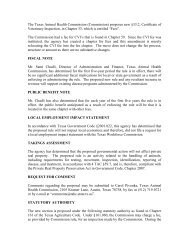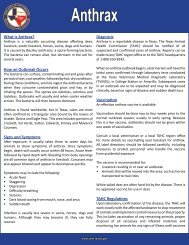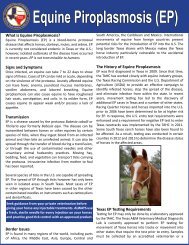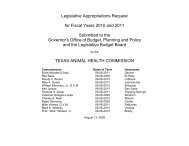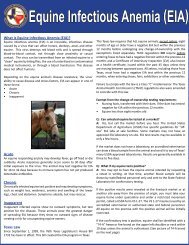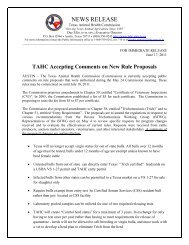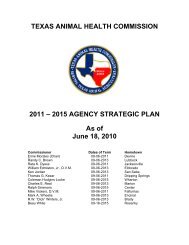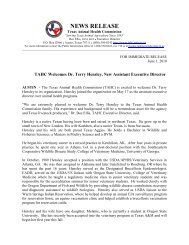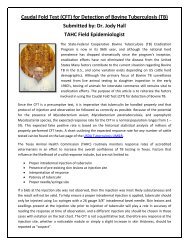TAHC Cattle Tuberculosis Brochure - Texas Animal Health ...
TAHC Cattle Tuberculosis Brochure - Texas Animal Health ...
TAHC Cattle Tuberculosis Brochure - Texas Animal Health ...
You also want an ePaper? Increase the reach of your titles
YUMPU automatically turns print PDFs into web optimized ePapers that Google loves.
TEXAS ANIMAL HEALTH COMMISSION• •<strong>Texas</strong>Since1893SERVING TEXAS ANIMAL AGRICULTURE<strong>Cattle</strong> <strong>Tuberculosis</strong>What is <strong>Cattle</strong> <strong>Tuberculosis</strong>?<strong>Cattle</strong> tuberculosis (TB) is a chronic debilitating disease of cattlecaused by the bacterium Mycobacterium bovis (M. bovis).Human tuberculosis, historically known as “consumption” wasusually caused by a closely related type of bacteria, but can becaused by the cattle strain as well. A variety of other speciesof animals may be susceptible to cattle tuberculosis, includingelk, deer, bison, goats, swine, and cats. Sheep and horses arerarely affected.<strong>Cattle</strong> TB is primarily a respiratory disease affecting the lungs,head and chest lymph nodes. It may also affect lymph nodesalong the animal’s digestive tract. Symptoms can includeprogressive weight loss, chronic cough and unexplained deathloss.<strong>Cattle</strong> TB has a long incubation period. It could be months oryears from the time an animal is infected until signs of illnessare noticeable. <strong>Tuberculosis</strong> was once the most prevalentinfectious disease found in cattle and swine in the U.S. In theearly part of this century, the disease caused more lossesamong U.S. farm animals than all other infectious diseasescombined.In 2000, <strong>Texas</strong> won a battle against cattle TB, earning the U.S.Department of Agriculture’s (USDA) TB accredited-free status.In 2002 however, that status was revoked when two infectedcattle herds were detected. After extensive testing, <strong>Texas</strong>regained its TB-free status from USDA in October 2006. Thiseffort included testing 2,014 purebred beef operations and all818 of the state’s dairies. Slaughter surveillance was alsogreatly enhanced at that time to ensure that any remainingTB infected herds would be detected.<strong>Cattle</strong> TB is most often detected through carcass inspection atslaughter plants. Internal lesions that are identified byinspectors are collected and forwarded to a laboratory forconfirmation of the disease. Efforts are made to track or“trace” the animal back to its herd of origin so that herdmatesor other exposed cattle can be tested.Like many other diseases, cattle TB transmission occurs moreeasily when animals are concentrated in close confinement.Infected animals normally spread the TB bacteria to their herdmates by expelling infected droplets from their lungs. Ingestionof the bacteria is also possible.The <strong>Texas</strong> <strong>Animal</strong> <strong>Health</strong> Commission (<strong>TAHC</strong>) is diligentlyworking with the <strong>Texas</strong> cattle industry to maintain <strong>Texas</strong>’ TBfreestatus. Several regulation changes have been implementedin recent years to aid in tracing exposed or diseased animals,and to help guard against re-introduction of TB.The following <strong>TAHC</strong> regulations help protect <strong>Texas</strong> cattlefrom TB:Dairy cattle, regardless of age or sex, must be identified priorto movement within <strong>Texas</strong> or entry into the state. Tags areNOT to be removed by subsequent owners.Sexually intact dairy cattle, two months of age and olderentering <strong>Texas</strong> from another state must:• Be individually identified and listed on a health certificateprior to movement• Be TB tested within 60 days prior to entering the state, or;• Originate from a TB free accredited herd, or;• Move directly to an approved slaughter establishmentwithout a TB test, or;• Move to an approved feedlot with a <strong>TAHC</strong> entry permitRegardless of reproductive status, test history, or MexicanState of origin, Holstein and Holstein cross cattle are prohibitedfrom entering <strong>Texas</strong> from Mexico due to the high prevalenceof TB in Mexican dairies.Sexually intact dairy cattle younger than two months ofage entering <strong>Texas</strong> from another state must:• Have a <strong>TAHC</strong> entry permit and be TB tested uponreaching two months of age• Be officially identified and accompanied by a healthcertificate.Mexican origin event cattle must:• Be retested in 60 to 120 days of entry into <strong>Texas</strong> fromMexico by a <strong>Texas</strong> veterinarian• Receive a permit prior to entry into the state fromanother state• Have an official permanent form of identification andbe listed individually on a health certificate prior toentry• Possess a current negative TB test performed withinprevious 12 months at all timesSexually intact beef cattle in <strong>Texas</strong> over 18 months of agemust have an official permanent form of identificationapplied prior to change of ownership
Why tag dairy cattle?Years of work may be expended tracing the movement ofTB infected or exposed cattle. Identification is crucial forepidemiologists to identify the source and movement ofdiseased or exposed animals, and to trace and preventspread of the disease. Dairy animals, managed in closeconfinement are at a greater risk for disease exposure ifan infected animal is in the herd. All dairy cattle MUSTbe tagged prior to movement, regardless of age or sex.Q: I’m a beef producer with one dairy cow; do I need totag her?A: Yes, she needs to be tagged before transporting tomarket or slaughter, or before being transferred toanother owner.Q: Who’s responsible for identifying dairy cattle beforemovement?A: The owner or manager of the animal is responsiblefor ensuring that dairy animals are identified beforemovement.Q: Is there additional record keeping?A: The owner is not required to keep records of theidentified animals.<strong>Texas</strong> A&M AgriLife Extension office, or go to the <strong>TAHC</strong>homepage, www.tahc.state.tx.us and find the nearestTag Allocation Partner.What types of Dairy ID are acceptable?• USDA alphanumeric tests tags (USDA silver tags)• USDA alphanumeric brucellosis calf-hood vaccinationtags (USDA orange tags)• Dairy Herd Improvement Association (DHIA) tags• Official breed registry tattoos or firebrand• Commercially produced cattle-style clip, flap orbutton tags that identify the dairy or owner andinclude a unique animal number in the herdUSDA approved <strong>Animal</strong> Identification Number (AIN) tagsfor official identification of individual animals.Three forms of official AIN tags are available:1. Manufacturer coded “900” series RFID tags, availablefrom many feed or supply stores2. USA prefix RFID tags3. Country code “840” series RFID tags. Producers whouse these must have their premises registeredQ: Where can I get tags?A: Contact your <strong>TAHC</strong> Region office, private veterinarian,Information provided by the:<strong>Texas</strong> <strong>Animal</strong> <strong>Health</strong> CommissionP.O. Box 12966 (mailing)Austin, TX 78711-29661-800-550-8242www.tahc.state.tx.usFind us on:Facebook: www.facebook.com/<strong>Texas</strong>AHCTwitter: www.twitter.com/<strong>TAHC</strong>December 2011



